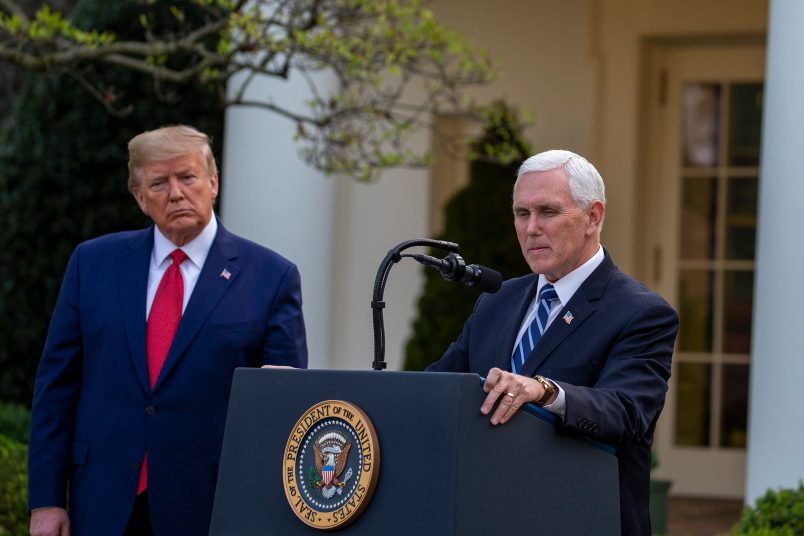Admiral Brett Giroir, who is coordinating the administration’s coronavirus testing efforts, reported at the Sunday White House press conference that the United States has performed more than 894,000 coronavirus tests to date, cheering that the number has “highly significantly increased every single day.”
But that figure pales in comparison to a promise President Donald Trump and Vice President Mike Pence have made repeatedly, for weeks: that millions of tests have already been distributed throughout the country.
Pence, who leads the administration’s coronavirus task force, said on March 10 that “over a million tests have been distributed,” with another 4 million to be distributed by that week’s end.
Three days later, President Donald Trump promised from the Rose Garden that 1.4 million tests would be distributed early in the week of March 16, and that a full 5 million tests will be available before the end of the month.
“I cannot explain the gap,” Trump said, referring to the discrepancy between tests distributed and those conducted, during another briefing a week later. “I’m hearing very good things on the ground.”
The White House, when reached Monday, also did not offer an explanation. Neither a spokesperson for Pence nor the HHS responded to requests for comment.
Trump has made other out-of-left-field promises pertaining to testing that have proved hollow, including that Google was setting up a digital resource for Americans to find out if and where they should be tested (news to the tech giant).
But on the testing discrepancy, it is not clear if fewer tests than promised have actually been distributed, or if there’s some delay on the other end with their implementation.
What is plain is that one crucial way to quash the spread of the outbreak, as done successfully (so far) by South Korea, is to implement aggressive and widespread testing to find out who has been exposed to the virus.
The country had conducted 395,194 tests as of Monday. The South Korean government has also been bombarding its population with constant updates about the whereabouts of newly detected cases, urging people to report to testing centers if they think they might have crossed paths with the infected people. Since early March, the country has seen a steady decline in cases.
Trump bragged on March 24 that “we’ve done more tests in eight days than South Korea has done in eight weeks,” a claim that seems to be factually wrong, but also relatively nonsensical. The United States’ population dwarfs South Korea’s by about six times over.
Meanwhile, the United States allowed a critical month between late January and early March to slip away without any mass testing, squandering the best chance to contain the virus. Now, the scarce tests in coronavirus hotspots are being saved for health-care workers and people sick enough to be hospitalized, meaning that many with mild or no symptoms can transmit the disease to others without even knowing they have it.
Dr. Anthony Fauci, director of the National Institute of Allergy and Infectious Diseases at the National Institutes of Health (NIH), told the House Oversight Committee on March 12 that the United States’ current system for coronavirus testing is “a failing.”
Since then, the United States has skyrocketed to an unenviable first place in the world tally, with 122,653 coronavirus cases as of Monday.







But my Numbers…I like my numbers…
But my Ratings…My ratings are higher than “The Bachelor”
But my Profits…How can I fleece thee?
OR are the promised Covid-19 tests FAILING per Fauci?
First of all Pence is as bad at numbers as Trump is, and just as good as lying. But even if the test kits where delivered, probably many went to places where they are still playing down the epidemic and don’t want to use them, like Texas, Florida and Alabama where you have to be outright kicking the bucket in order to get a test, because they don’t want their numbers to rise.
We should be talking about a billion or even two billion tests for the US alone. The new rapid POC tests are coming now. For those countries with some installed base like South Korea, Japan, Sweden, Germany and Finland, the cost per test should be under $2 a test. The charge on a central lab PCR in the US is $85-$100! There’s an obstacle right there. And even famous, rich people are having trouble getting timely tested. Home antibody test kits should be distributed free, so families who have been infected, maybe were asymptomatic, can go back to normal life such as it is. It might be worthwhile to have a testing czar as this testing issue will go on for a long time, and the opportunities for egregious price gouging remains.
Because Resident Rump is allergic to the truth?
That started well before his presidential campaign. It’s on his birth certificate, one may surmise.
America knew what it would get: a pathological liar and his ilk.
Ooh, ooh, I know this one, and so does every other non-cult voter.